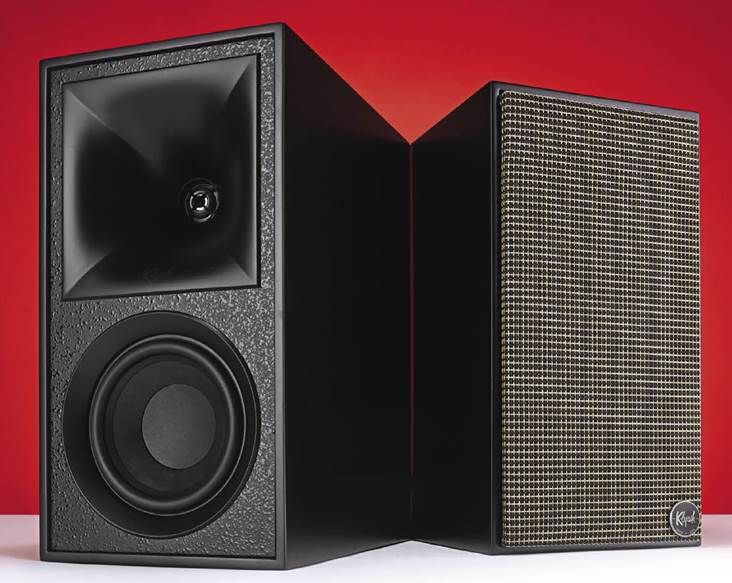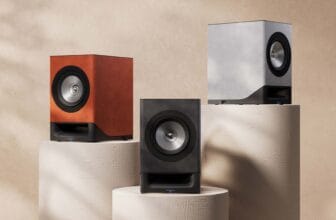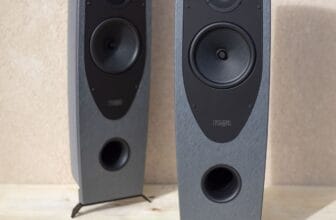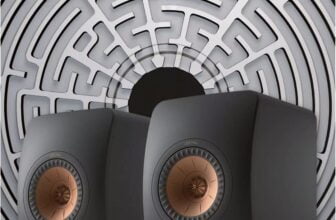KLIPSCH THE FIVES Review – High Fives
Klipsch The Fives loudspeakers offer the lot for under £1k, impressing Noel Keywood. Read our KLIPSCH THE FIVES Review.
With these little loudspeakers you get a whole hi-fi system, albeit without source. Klipsch The Fives pack a massive amount of technology into a small space and I could barely find anything to fault, they are so carefully engineered. “The most versatile loudspeakers on earth” Klipsch say – and I agree.
What you get here is one active loudspeaker (right) carrying all the electronics, so it’s connected to mains power via a lead with small two-pin ’calculator’ connector, easily replaced if the 3m long one supplied is too short. The other loudspeaker is passive, driven though a 4m (12ft) long connecting cable. The right loudspeaker can be placed at left if this is nearer a mains socket, but then the stereo sound stage is reversed, not a big issue for most potential users I suspect.
The main loudspeaker comes packed with ability. It has a 60 Watt stereo low frequency amplifier feeding left and right bass units, and 20 Watt stereo high frequency amplifiers feeding left and right treble horns, giving 80 Watts total per channel – enough for very high volume.
There are so many input options it was almost bewildering. There are S/PDIF digital inputs, optical and electrical, plus a USB input for computer connection. The S/PDIFs can, for example accept the digital output of a CD player. Klipsch note that the optical input works up to 192kHz sample rate – and it does I found.
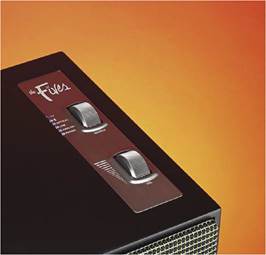
Large thumb wheels atop the right loudspeaker control volume and select input. The input LED display doubles as a volume level display.
Then there are analogue inputs, comprising a pair of Line level phono sockets that can be switched to accept the output of a turntable fitted with moving magnet (MM) cartridge. For convenience there is also a 3.5mm stereo jack input, using a socket found on mobile you have to accept Class D amps driven by a switch-mode power supply (I would guess) and a digital convertor that is low cost, as I was to find out.
In spite of this huge range of options and the background technical complexity, including active crossover and twin power amps, The Fives were quick and easy to set up and use; even the manual (downloadable from Klipsch website) has been shorn down to simple diagrams that I found clear and succinct. It’s a plug ’n play job in effect and all worked perfectly, straight out of the box. Select input from one thumb wheel atop the right active speaker and control volume with the other. But there is a remote control to do all this, including turning power on and off.
Klipsch build in a dynamic EQ system as they call it, in effect what was once termed a ‘loudness control’. At low volume it increases bass output to compensate for the ear’s lack of low frequency sensitivity at low volume. Measurement revealed phones and portable players to allow use of a simple 3.5mm connecting lead, rather than a 3.5mm-phono adaptor lead. No probs with getting high volume since our measurements showed both are very sensitive.
But that is far from all. This loudspeaker accepts the Bluetooth output of a mobile ‘phone as well, for wireless connection.
And finally it has an HDMI input to accept audio from the ARC return channel of a video player or TV with HDMI ARC equipped connector. The latter is to make for easy connection into any A/V system, allowing these little wonders to replace a sound bar. Sound bars are a convenience but they should sit under the screen, whereas independent loudspeakers can be placed at left and right, possibly either side of a chimney breast if you live in an old building with such things, as I do.
Klipsch have covered just about all angles here. At the price and small size +5dB maximum bass lift at low volume and if this doesn’t please, possibly when listening close up at low volume in a small bass-heavy room, it can be switched out on the remote control. As volume goes up bass boost comes down progressively with these systems. There are no tone controls.
The cabinets are 305mm high, 166mm wide and 235mm deep, weighing 5.35kg / 4.85kg apiece. Bass comes from a small 4.5in (120mm) paper cone woofer and treble from a 1in (25mm) titanium dome tweeter loaded by a large Tractrix profile horn. At rear there is a Tractrix port.
SOUND QUALITY
The Fives have vivid dynamics making them sound lively and bold – meant in the best sense. There was no shortage of bass even with Bass EQ switched out. In fact, I checked a few times just to make sure because bass was on the heavy side for my taste, even in our large (6550 cu ft) listening room where small loudspeakers can sound lost. The trombone behind Hans
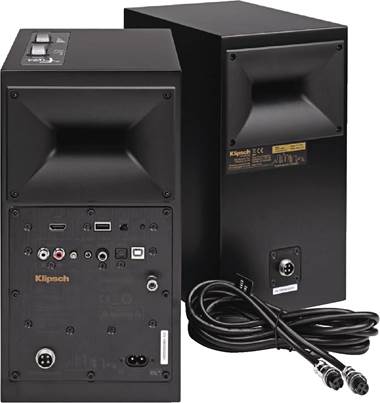
The right loudspeaker (at left in this picture) carries a small 110V240V mains input, a four pin connector for the right passive speaker, plus an array of digital and analogue inputs. The RCA phono sockets are switched between Line and Phono for a turntable. There is a subwoofer output too.
Theessink singing Mississippi was a little bloated I felt, but full bodied that’s for sure – and with a sense of scale. There was a boxy warmth that made The Fives sound large and fruity, out of all proportion to their real-life size.
The horn loaded tweeter has its own sense of presence too, forcing out highs. From measurement I expected a slightly softer presentation but The Fives came over as hard and fast across the midband, up to the point of being a tad brash at times. Why?
I started out feeding in CD digitally by using a QED Quartz glass fibre optical cable from our Oppo BDP-205D Universal player acting as a transport. Reviewing The
“What you get with these ‘speakers is a big, gutsy American sound”
Sixes (February 2020 issue) Jon Myles preferred analogue. When I connected up the Oppo’s analogue outputs, bringing into play it’s ESS DAC, this smoothed the sound. So did analogue from our Timestep Evo Technics SL-1210 Mk2, SME309 arm, Audio Technica VM-750SH Shibata tipped moving magnet cartridge. Conclusion: a not brilliant digital section – as is to be expected at the price, analogue sounding best.
Difficult to explain this, but digital sounded more lively – sharper and faster – than analogue, yet more unsettling in the long run. Analogue was a smoother and easier listen.
Although my words may seem a little critical, at the same time I enjoyed what I heard after spinning through a wide range of CDs. What you get with these ‘speakers is a big, gutsy American sound shall I say, not for wimps!
Yet at the same time there was none of the obvious tonal imbalance – especially from raised treble – that pollutes so many UK loudspeakers nowadays. Klipsch don’t do that. They keep it clean and accurate,

although gain of the bass amp has been moved up just a tad on the treble amp to ensure a sound with warmth and heft – something that’s easy to arrange with separate amps.
Operationally I ran into no problems. The volume control was a bit over-eager at times but I managed to get the volume I wanted in the end. And if you want deep bass The Fives actually do it at normal volume levels; at high volume the small 5in bass unit gets over excited, as small drivers do when trying to move oodles of air.
CONCLUSION
Great fun loudspeakers that attempt to blow the windows out. Klipsch The Fives are small, but sound large.
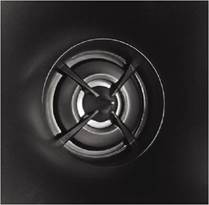
A 1 inch (25mm) titanium dome tweeter with phase cap and Tractrix horn loading that gives it wide dispersion and optimal acoustic coupling.
Wide dispersion gives big sound staging and there’s plentiful bass. With more inputs than “all others on earth” Klipsch say, they are massively capable too. The digital section isn’t distinguished, but this apart The Fives are a thoroughly superb set of active loudspeakers.
MEASURED PERFORMANCE
Frequency response of the small Klipsch The Fives ran impressively flat from 35Hz up to 18kHz. The horn loaded tweeter was very smooth on and off axis under measurement, unlike most budget loudspeakers.
Bass output was strong and well maintained down to 50Hz, the rear port peaking sharply at 50Hz (red trace) to augment output. So, strong bass that goes low, the port adding to ‘bass speed’. An analysis of bass amp response showed peaking at 40Hz so the sound has been tailored for strong low bass.
In frequency response terms this is a very accurate loudspeaker with wide
FREQUENCY RESPONSE
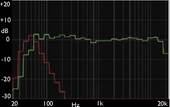
BASS EQ AT LOW VOLUME
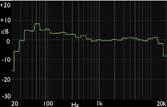
dispersion of sound, suggesting good insight from a present midrange and plenty of detail, not over emphasised.
Sensitivity through the analogue Line input was high at 80mV for a loud 90dB sound pressure level at one metre, sufficient to accept the headphone output of a ‘phone – typically 1000mV – with plenty of leeway on the volume control.
A full level digital input gave 90dB again with volume to spare, so no problems here in terms of volume matching. Frequency response was identical to the analogue inputs, meaning there are no fundamental response issues with the DAC used. But high- ish noise and distortion levels, plus the presence of a huge out-of-band alias signal point to cost-cut digital processing.
The Phono stage drove the Fives to a loud 90dB from a 5mV input with plenty to spare on the volume control and frequency response was identical to the Line input (with an inverse RIAA equalised pink noise input), so an accurate phono stage.
The Fives measured well through analogue and not so well through digital inputs. They have been engineered to give an almost unusually accurate response though, that will come over as smooth and natural – good for long term enjoyment.
KLIPSCH THE FIVES
OUTSTANDING – amongst the best.
VALUE – keenly priced.
VERDICT
When you purchase through links on our site, I may earn an affiliate commission. Here’s how it works.
Henley Audio +44 (0)1235 511166 www.henleyaudio.co.uk
